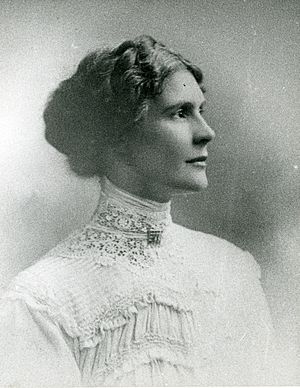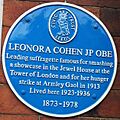Leonora Cohen facts for kids
Quick facts for kids
Leonora Cohen
|
|
|---|---|
 |
|
| Born |
Leonora Throp
15 June 1873 Leeds, England
|
| Died | 4 September 1978 (aged 105) Colwyn Bay, Wales
|
| Nationality | British |
| Occupation | Milliner and activist |
| Employer | Women's Social and Political Union |
| Known for | Vandalism at the Tower of London |
| Spouse(s) |
Henry Cohen
(m. 1900; died 1949) |
| Children | 2 |
Leonora Cohen (born Throp; 15 June 1873 – 4 September 1978) was a British suffragette and trade union activist. A suffragette was a woman who fought for the right to vote in elections. Leonora was also one of the first women to become a magistrate, which is like a judge in local courts.
She was known as the "Tower Suffragette" because she broke a display case in the Tower of London as a protest. She also worked as a bodyguard for Emmeline Pankhurst, a famous leader of the suffragette movement. Leonora Cohen lived to be 105 years old and even helped with the second wave of feminism in the 1970s, which was another time when women fought for more equal rights.
Contents
Early Life and Family
Leonora Throp was born in Hunslet, Leeds, England, on 15 June 1873. Her father, Canova Throp, was a sculptor. He died when Leonora was only five years old. This meant her mother, Jane, had to raise Leonora and her two younger brothers by herself. Her mother worked hard as a seamstress to support the family.
Leonora learned to be a milliner, someone who makes and sells hats. While working, she met Henry Cohen, who worked in a jewelry shop. Henry was a childhood friend, but both their families did not want them to marry. Despite this, Leonora and Henry married in 1900.
Their first child, Rosetta, sadly died in her first year. In 1902, Leonora gave birth to her son, Reginald, who grew up healthy. For several years, the family lived a peaceful life as Henry's jewelry business did well.
Why Leonora Became a Suffragette
Leonora's mother, Jane, greatly influenced her. Because her mother was a widowed seamstress raising three children alone, Leonora saw how few rights women had in Britain in the late 1800s.
In an interview much later in her life, Leonora said that life was very difficult for women. She remembered her mother saying, "Leonora, if only we women had a say in things." Leonora saw that even a man who was not responsible had a vote just because he was male, while her hardworking mother had no say. This made Leonora promise herself that she would try to change things. She realized early on that her mother faced huge challenges simply because she was a woman. This unfairness made Leonora want to fight for women's rights.
Her job also played a part. When Leonora first worked as a milliner, there was a movement to improve working conditions for women. This made her think about how women were treated in the workplace. Luckily, Leonora's husband, Henry, supported her fight for women's rights.
Taking Action for Women's Rights
Leonora Cohen took many strong actions to protest against the government. In 1909, she joined the Leeds branch of the Women's Social and Political Union (WSPU). This group was started by Emmeline Pankhurst in 1903 and fought for women's right to vote. Later, Leonora became part of 'The Bodyguard', a group that protected Mrs. Pankhurst.
In 1911, Leonora joined a protest where she broke a window at a government building. She was arrested and held in Holloway Prison for seven days. She spoke for herself in court and, even though she was found guilty, she was released. She also faced rough treatment from the police during a protest near the House of Commons. As Leonora became more active as a suffragette, her family supported her, but some friends did not. She received unkind letters, and her son faced difficulties at school because of her actions.
In 1913, Leonora protested by using an iron bar to smash a glass case at the Tower of London. This case held important items belonging to the Order of Merit. Leonora was arrested again and sent to Armley Gaol prison. There, she went on a hunger strike, refusing to eat. Because of a law called the Cat and Mouse Act, Leonora was released from prison after a few days to recover from not eating. After this, Leonora and Henry Cohen moved to Harrogate. They opened a vegetarian guesthouse and also offered a safe place for other suffragettes who were trying to avoid the police.
The WSPU gave Leonora a Hunger Strike Medal for her bravery.
In 1913, suffragette leaders Annie Kenney and Flora Drummond arranged for WSPU members to talk with important politicians like David Lloyd George and Sir Edward Grey. The women explained the low pay and poor working conditions they faced. They hoped that having the right to vote would allow women to improve their lives in a fair way. Leonora Cohen explained that if women could vote, they would have the power to demand better wages, just as men did. This would help prevent young women from being forced into difficult situations because of low pay.
Leonora also helped other suffragettes. She once dressed up as a baker's delivery man to help fellow suffragette Lilian Lenton escape from a house where she was recovering from a hunger strike.
A dress Leonora wore to a ball in 1914 had suffragette symbols and the WSPU logo on it. This dress is now kept at the Leeds Discovery Centre.
After the First World War, Leonora and her family moved back to Leeds. Leonora became an organizer for the National Union of General and Municipal Workers in Leeds. She helped workers with their demands, including leading a three-day strike. She also served as president of the Leeds Trades Council.
By 1923, Leonora Cohen became the first woman president of the Yorkshire Federation of Trades Councils. In 1924, she was made a magistrate. She was one of the first women to be appointed to this role and served as a Justice of the Peace (JP) for 25 years. In 1928, she was awarded the Order of the British Empire (OBE) for her public service.
Later Life and Legacy
Leonora Cohen retired and moved to Colwyn Bay in north Wales. In 1970, she attended the unveiling of the Suffragette Memorial in London. In 1973, she even visited the Tower of London again, the place where she had protested so many years before.
Because Leonora lived to be 105, she saw the second wave of feminism in the 1970s. This brought her back into the public eye. Historian Brian Harrison interviewed over 200 people for his project on the suffragette movement, including Leonora. In her 1974 interview, Leonora talked about the 1911 rally and her first arrest. She described the large crowds and how she was knocked down by a mounted policeman.
In 1974, she appeared on the cover of Radio Times magazine to promote a TV series called Shoulder to Shoulder, which was about the history of the women's suffrage movement. In the photo, she wore her Holloway brooch and Hunger Strike Medal.
Scholars have studied Leonora's life as a suffragette. Some have noted that her vegetarianism was linked to her feminism. For example, not having to prepare meat meant women could spend less time in the kitchen. This gave them more time to pursue other interests outside the home.
Death and Remembering Leonora

In the 1960s, Leonora Cohen gave her scrapbook, many papers, and other special items to the Abbey House Museum in Leeds. Her scrapbook shows what inspired her to become a suffragette. It also shows her interest in current events, as it included an article about the death of Nurse Edith Cavell. The collection also had a painting of Leonora as a child, done by her father.
Leonora Cohen died in 1978, at the age of 105. The Times newspaper published an article about her life. It mentioned her OBE award, her role as a bodyguard for Mrs. Pankhurst, her time in prison, her hunger strike, and her nickname "Tower Suffragette" for the protest she made at the Tower of London. She was seen as an important activist from her region.
Leonora had attached a note to the iron bar she used to smash the glass cabinet in the Tower. It said: "Jewel House, Tower of London. My Protest to the Government for its refusal to Enfranchise Women, but continues to torture women prisoners – Deeds Not Words. Leonora Cohen." On the back, it read: "Votes for Women. 100 years of Constitutional Petition, Resolutions, Meetings & Processions have Failed." This note clearly explained why she took such a bold action.
An interview with Leonora Cohen for her 100th birthday appeared in the North Wales Weekly News. In it, she explained why and when she joined the suffrage movement and the actions she took.
Images for kids
-
Blue Plaque in Leeds, honoring Leonora Cohen
See also
 In Spanish: Leonora Cohen para niños
In Spanish: Leonora Cohen para niños


